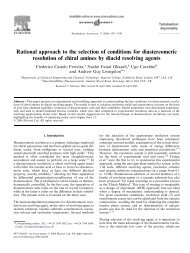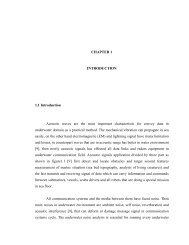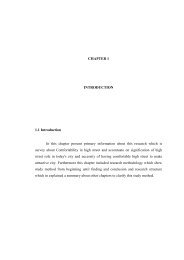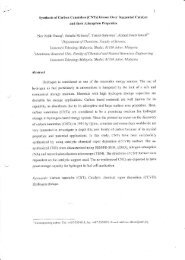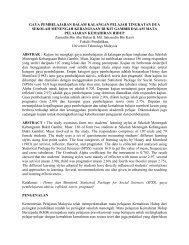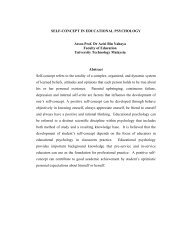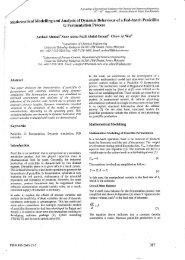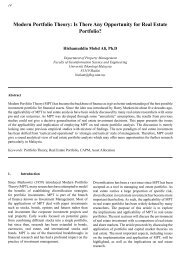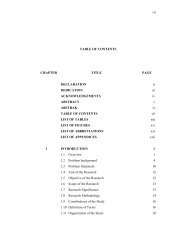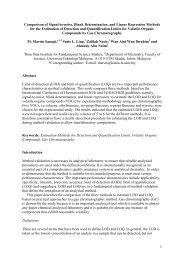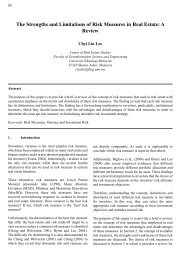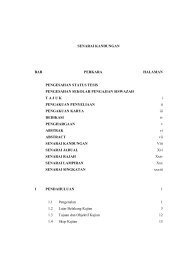A Connectionist System Approach for Learning Logic Programs
A Connectionist System Approach for Learning Logic Programs
A Connectionist System Approach for Learning Logic Programs
You also want an ePaper? Increase the reach of your titles
YUMPU automatically turns print PDFs into web optimized ePapers that Google loves.
A <strong>Connectionist</strong> <strong>System</strong> <strong>Approach</strong> <strong>for</strong> <strong>Learning</strong> <strong>Logic</strong> <strong>Programs</strong><br />
M. Hadi Mashinchi, Siti Mariyam Hj. Shamsuddin<br />
Faculty of Computer Science & In<strong>for</strong>mation <strong>System</strong>s, University of Technology Malaysia<br />
h_mashinchi@yahoo.com, mariyam@utm.my<br />
Abstract<br />
In this paper, we show that temporal logic can be<br />
learnt effectively by a connectionist system. In contrast<br />
with other connectionist approaches in this context, we<br />
focus more on learning rather than knowledge<br />
representation. In order to learn from temporal logic<br />
values, the paper proposes a general three-layer<br />
connectionist system regardless of the number of logic<br />
rules, a condition which must have been satisfied in<br />
previous approaches. A mapping function is proposed<br />
to convert logic rules to the proper connectionist<br />
system’s inputs. Then a simulation study is carried out<br />
<strong>for</strong> muddy children puzzle. The results of the study<br />
suggest that an agent embedded with a connectionist<br />
system can learn temporal logic efficiently. It is<br />
observed that the connectionist system can increase its<br />
per<strong>for</strong>mance and make fewer mistakes while<br />
encountering with more produced cases of given<br />
logical rules.<br />
1. Introduction<br />
There is no doubt that logic and connectionist<br />
systems are two distinct areas in computer science,<br />
which are related to symbolic artificial intelligence and<br />
soft computing respectively. It has been recognized<br />
that the ability to represent and reason about structured<br />
objects is crucial <strong>for</strong> rational agents where in this case<br />
computational logic is a good choice [1]. Also to<br />
per<strong>for</strong>m very intelligently, rational agents need<br />
additional abilities such as learning, adapting to new<br />
environments and degrading gracefully which are not<br />
reachable within logic-based agents solely [2]. The<br />
latter abilities can be satisfied by connectionist<br />
systems. There<strong>for</strong>e, great ef<strong>for</strong>ts have been undertaken<br />
to hybridize logic programs and connectionist systems.<br />
Hybrid approaches have been introduced recently in<br />
which a connectionist system is applied <strong>for</strong> knowledge<br />
representation and reasoning [3, 4, 5, 6].<br />
To apply connectionist system <strong>for</strong> knowledge<br />
representation, specific connectionist system’<br />
architecture should be defined at the starting point. The<br />
978-1-4244-1968-5/08/$25.00 ©2008 IEEE 852<br />
architecture is defined based on the primary logical<br />
rules and the facts that the agent already knows or<br />
believes. Predefined architecture specification makes<br />
rational agents inefficient <strong>for</strong> any cases that new<br />
logical rules require to be added and learnt by agent as<br />
time goes on. This inefficiency occurs because once<br />
the architecture is defined and the weights are adapted<br />
based on the primary logic rules, it is hard to change it<br />
to be suitable <strong>for</strong> more new rules. There are two main<br />
reasons <strong>for</strong> this difficulty in reality. Firstly, as logical<br />
rules are added to rational agent’s knowledge during<br />
time, an additional task needs to be carried out to find a<br />
new proper architecture that is suitable with present<br />
knowledge. Secondly, when the proper weights are<br />
recognized via learning, changing the architecture will<br />
destroy all prior knowledge in weights that have been<br />
gained with primary architecture. Thus, in this paper,<br />
we proposed a general architecture. There<strong>for</strong>e, new<br />
rules can be learnt by the agent without any<br />
difficulties; such as finding proper architecture or<br />
missing prior gained knowledge which both are time<br />
consuming.<br />
In this paper, we pursue the logic connectionist<br />
system proposed by Garcez et al. [3, 4, 5] but with<br />
focusing on the learning aspect of the logic<br />
connectionist system rather than knowledge<br />
representation. In contrast to other logic connectionist<br />
systems, <strong>for</strong> example those proposed in [3, 4, 5], we<br />
propose a mapping function and a 3-layer feed-<strong>for</strong>ward<br />
connectionist system with a general architecture to<br />
learn from temporal logic rules. This paper shows that<br />
there is no need in equal numbers of hidden neurons<br />
and logic rules, a condition that needs to be satisfied in<br />
the approach by Garcez et al. [3, 5, 7]. The general 3layer<br />
connectionist system can be very beneficial when<br />
an agent per<strong>for</strong>ms in dynamic environment which<br />
learning aspect is essential.<br />
The rest of the paper is organized as follows. In<br />
Section 2, the muddy children puzzle is described as a<br />
motivating example. Then, a temporal logic example is<br />
provided to show how it can be learnt by a<br />
connectionist system. A mapping relation from<br />
temporal rules to connectionist system’s inputs is
discussed in Section 3. A simulation study <strong>for</strong> the<br />
muddy children puzzle is carried out in Section 4. The<br />
conclusions and future research directions are<br />
discussed in Section 5.<br />
2. <strong>Connectionist</strong> system <strong>for</strong> learning<br />
temporal logic<br />
The muddy children puzzle [8] has been used as a<br />
running scenario throughout this paper. The Same<br />
puzzle has been applied <strong>for</strong> verification of logic<br />
connectionist systems in [6, 7]. This section later<br />
shows how a three layer connectionist system with a<br />
general architecture can be modeled to learn the<br />
temporal logic engaged in the puzzle.<br />
In general, there are n intelligent children, where<br />
k ( k ≤ n ) of them have mud on their <strong>for</strong>eheads. They<br />
will then be asked if any of them knows that they have<br />
mud on their own <strong>for</strong>eheads. They have been told that<br />
at least one of them is muddy. They can see the other<br />
children’s <strong>for</strong>eheads and can hear them respond after<br />
each question is asked. For simplicity, suppose that<br />
only three of them are playing. First consider the case,<br />
that k = 1 and child 1 is the muddy one. Since he can<br />
see the other two children who are not muddy, he<br />
concludes that he should be the only muddy one. Thus,<br />
in the first time that they are asked, he says: “Yes, I am<br />
muddy”. There<strong>for</strong>e in the second time both child 2 and<br />
3 can conclude that they are not muddy. Next case is<br />
k = 2 with the assumption that child 1 and child 2 are<br />
muddy ones (other cases can be treated similarly). In<br />
the first time all children answer that they do not know<br />
if they are muddy or not, since each of them can see at<br />
least one muddy child. But in the second time, child 1<br />
can infer that he is muddy, as child 2 was not sure<br />
about his <strong>for</strong>ehead being muddy so he must see another<br />
muddy child. Since child 3 is not muddy, thus he<br />
himself has to be muddy in the <strong>for</strong>ehead. Child 2 can<br />
infer similar to child 1, so in the second time both say<br />
“Yes, I am muddy”. The child 3 infers that he is not<br />
muddy when he is asked <strong>for</strong> the third time. The final<br />
case is when k = 3.<br />
In this case, in the first and<br />
second rounds none of the children knows whether he<br />
is muddy or not. This causes child 1, in third round, to<br />
infer that if child 2 and child 3 are the only muddy<br />
ones they must say “Yes” in the second round, thus, I<br />
myself should be muddy. Child 2 and 3 can infer<br />
similarly, so all say “Yes, I am muddy” in the third<br />
round.<br />
This is an example of a muddy children puzzle in<br />
which each child as an agent needs to conclude based<br />
on his own individual’s and others’ knowledge [6, 7].<br />
The logic rules <strong>for</strong> agent 1 are illustrated in Table 1.<br />
Agents 2 and 3 can be treated similarly.<br />
853<br />
Table 1: <strong>Logic</strong> rules <strong>for</strong> agent 1.<br />
1<br />
r1<br />
: K1q1<br />
∧ K1¬<br />
p2<br />
∧ K1¬<br />
p3<br />
→ K1<br />
p1<br />
1<br />
r2<br />
: K1q2<br />
∧ K1¬<br />
p2<br />
∧ K1<br />
p3<br />
→ K1<br />
p1<br />
1<br />
r3<br />
: K1q2<br />
∧ K1<br />
p2<br />
∧ K1¬<br />
p3<br />
→ K1<br />
p1<br />
1<br />
r4<br />
: K1q3<br />
∧ K1<br />
p2<br />
∧ K1<br />
p3<br />
→ K1<br />
p1<br />
1<br />
r5<br />
: K1q1<br />
∧ K2<br />
p2<br />
→ K1¬<br />
p1<br />
1<br />
r6<br />
: K1q1<br />
∧ K3<br />
p3<br />
→ K1¬<br />
p1<br />
r : K q ∧ K p ∧ K p → K ¬ p<br />
1<br />
7<br />
1<br />
2<br />
2<br />
2<br />
In Table 1, K i represents the knowledge operator<br />
<strong>for</strong> agent i . Also, propositions i p and q i say that p<br />
and q stand true <strong>for</strong> agent i , where i p and q i mean<br />
that agent i is muddy and i numbers of agents are<br />
muddy, respectively. There<strong>for</strong>e, <strong>for</strong> example,<br />
means if agent 1 knows that one of the agents is muddy<br />
and also knows agent 2 and agent 3 are not muddy, so<br />
agent 1 can conclude that he must be muddy. It is also<br />
assumed that when none of the antecedents are<br />
satisfied then the agent replies “I don’t know”.<br />
A three-layer connectionist system is applied to learn<br />
from the logical rules in Table 1. In contrast with other<br />
approaches [3, 4, 5, 9], the connectionist system that is<br />
applied here focuses more on the learning ability rather<br />
than knowledge representation. Also, it does not need<br />
the number of neurons in the hidden layer to be equal<br />
to the number of logical rules which is assumed in [3],<br />
[6, 9]. A three-layer connectionist system is illustrated<br />
in Figure 1 <strong>for</strong> learning the rules stated in Table 1. In<br />
this figure, by agent’s status, we mean the answer of<br />
the agent regarding the question.<br />
My status<br />
Agent 1’s status Agent 2’s status My current knowledge<br />
regarding number of the<br />
muddy agents<br />
Figure 1: A connectionist system <strong>for</strong> an agent to learn the<br />
rules provided in Table 1.<br />
In Figure 1, each neuron is connected to the other<br />
neurons through a connectionist weight. The ultimate<br />
aim is to find the best connectionist weights, so that the<br />
connectionist system can mimic the logical rules that<br />
are believable by the agent.<br />
Any agent’s status can be obtained via interaction with<br />
other agents. The “number of muddy agents”, is a<br />
3<br />
3<br />
1<br />
1<br />
r<br />
1<br />
1
necessary input <strong>for</strong> each agent to conclude whether he<br />
himself is muddy or not. In addition, each agent needs<br />
to have temporal logic rules as those presented in Table<br />
2 to infer how many agents are muddy [7].<br />
Table 2: Temporal rules <strong>for</strong> “numbers of muddy agents” in<br />
agent i .<br />
Starting :<br />
K q<br />
First<br />
i<br />
1<br />
1<br />
1<br />
Second<br />
round :<br />
¬ K p ∧ ¬ K p ∧ ¬ K p → K q<br />
1<br />
1<br />
2<br />
round :<br />
2<br />
2<br />
¬ K p ∧ ¬ K p ∧ ¬ K p → K q<br />
2<br />
In Table 2, the temporal operator refers to the<br />
knowledge that each agent applies in the next round.<br />
For example, in the first round, if all agents do not<br />
know their status, then each agent can conclude that<br />
there exist at least two muddy agents and this<br />
knowledge can be used <strong>for</strong> the second round.<br />
Agent 2<br />
Agent 2<br />
status<br />
My status<br />
Goes to<br />
agent 1 From agent 1<br />
Goes From agent 3<br />
to agent 3<br />
Number of muddy<br />
Figure 2: Interaction between agents.<br />
Figure 2 shows the interaction between agents <strong>for</strong><br />
acquisition of knowledge. For the connectionist system<br />
to be able to learn from logical rules, the proper inputs<br />
need to be constructed. In Figures 1 and 2, the two<br />
most left inputs <strong>for</strong> each agent are easily obtainable.<br />
But <strong>for</strong> an agent to infer how many agents are muddy<br />
at the moment the temporal rules in Table 2 need to be<br />
converted to proper inputs. In the next section, a rule-<br />
3<br />
3<br />
3<br />
3<br />
Agent 1<br />
Agent 1<br />
status<br />
Goes to<br />
agent 2 From agent 2<br />
Goes From agent 3<br />
to agent 3<br />
Agents 3<br />
Agent 3<br />
status<br />
i<br />
i<br />
2<br />
3<br />
My status<br />
Number of muddy<br />
My status<br />
Goes to<br />
agent 1 From agent 1<br />
Goes From agent 2<br />
to agent 2<br />
Number of muddy<br />
854<br />
input mapping function is proposed <strong>for</strong> the muddy<br />
children puzzle.<br />
3. Rule-input mapping function<br />
To apply a connectionist system, the logic rules are<br />
required to be converted to suitable inputs and outputs.<br />
For the muddy children puzzle, each agent needs to<br />
know the others status and the number of muddy<br />
agents. The agents can easily know about the others’<br />
status, since they can see each other. Furthermore, each<br />
agent can conclude that at least n muddy agents exist,<br />
th<br />
if in n round all agents reply “I don’t know” to the<br />
question.<br />
Suppose that agent 1 is not muddy himself (although<br />
he doesn’t know it at the first stage) and can see that<br />
agent 2 is not muddy and agent 3 is muddy. Thus, in<br />
the first round agent 3 says he is muddy while the<br />
agents 2 and 3 say “I don’t know”. When in the second<br />
time agents 2 and 3 are asked whether they know their<br />
status or not, they need to remember that one agent has<br />
claimed his muddy status. Thus, they can not be<br />
muddy. In case, they don’t remember that one has<br />
claimed, they can not infer correctly. So, in addition to<br />
the number of rounds, another input should be<br />
considered to recall the claims of other agents.<br />
Thus, <strong>for</strong> the puzzle with three agents, four inputs<br />
are necessary. These are; other agents’ status, round<br />
number and one input to know if any agent has claimed<br />
(others’ claim) his status.<br />
4. Simulation and results<br />
A muddy puzzle with five agents (children) is used<br />
<strong>for</strong> simulation. Then, a three-layer connectionist<br />
system with 6 neurons in the hidden layer, 6-6-1<br />
architecture, is applied to learn from different<br />
situations that an agent encounters randomly. It is<br />
worth mentioning that if the approaches in [3, 5, 7] are<br />
applied, more neurons and complicated architecture are<br />
necessary <strong>for</strong> a connectionist system.<br />
Each agent can give three answers: “yes”, “no” or “I<br />
don’t know” which are implemented as 1, 0 and 0.5 as<br />
the output <strong>for</strong> the connectionist system, respectively.<br />
We trained the agent <strong>for</strong> 1 to 150 random situations<br />
with back-propagation learning method. The<br />
per<strong>for</strong>mance of the trained agent is then assessed with<br />
50 random situations <strong>for</strong> 100 times. Since after<br />
training, the connectionists system’s output can have<br />
outputs in any range, the following conditions are<br />
applied to have only 1, 0 and 0.5 as the output.<br />
if<br />
if<br />
if<br />
output ≤ 0 . 25 then output = 0<br />
output ≥ 0 . 75 then output = 1<br />
0 . 25 < output < 0.<br />
75 then output = 0.<br />
5
Figure 3 shows the convergence of the average error<br />
<strong>for</strong> 100 runs. Fifty random situations are considered <strong>for</strong><br />
each run. As expected, encountering with more training<br />
situation, each agent can have better understanding of<br />
whole puzzle’s rules. The agent average error was 70<br />
percent in the beginning which decreased to about 10<br />
percent after encountering with 40 training situations.<br />
Figure 3: A connectionist system <strong>for</strong> an agent learning the<br />
rules provided in Table 1.<br />
Also the agent’s function becomes more trustable<br />
and the fluctuations are reduced after about 40<br />
situations and it smoothly converged to zero.<br />
5. Conclusions and future works<br />
In this paper, we have applied a connectionist system<br />
with focus on the aspect of learning logic rules rather<br />
than knowledge representation [3, 4, 5]. In contrast to<br />
the approach by Garcez et al. [3, 5, 6, 9], we proposed<br />
a general connectionist system in which there is no<br />
need in equal numbers of hidden neurons and the logic<br />
rules of a problem, a condition which is assumed in [3,<br />
5, 7, 9]. According to the simulation, a rational agent<br />
can learn from temporal logic-based situations<br />
efficiently. After training, it can per<strong>for</strong>m intelligently<br />
based on the direction of learnt logical rules and can<br />
guess unlearnt rules effectively. It has been observed<br />
that as the intelligent agent sees more situations, the<br />
approximation of expected actual logic rules gets<br />
better.<br />
As a future research direction, we are interested to<br />
investigate cases in which other agents that share the<br />
knowledge are not very intelligent or trustworthy. In<br />
this case, <strong>for</strong> instance, if an agent in muddy children<br />
puzzle replies that he has mud on his <strong>for</strong>ehead, it might<br />
not be necessarily correct. This may occur if the agent<br />
is not intelligent enough. Thus, he might conclude<br />
wrongly. Consequently, other agents infer incorrectly<br />
based on the wrong in<strong>for</strong>mation provided by this agent.<br />
Since an agent does not know about the other agents’<br />
855<br />
intelligence capability, there is uncertainty. There<strong>for</strong>e,<br />
fuzzy connectionist systems [10, 11] which are able to<br />
learn from fuzzy input-outputs, can be applied to take<br />
this uncertainty into consideration.<br />
6. Acknowledgment<br />
Authors would like to thank Research Management<br />
Center (RMC) of Universiti Teknologi Malaysia and<br />
Ministry of Higher Education (MOHE), Malaysia <strong>for</strong><br />
their valuable supports.<br />
7. References<br />
[1] J. A. Fodor, Z. W. Pylyshyn, “Connectionism and<br />
cognitive architecture: A critical analysis” In: S. Pinker, J.<br />
Mehler (Eds.) Connections and Symbols, MIT Press, 1988,<br />
pp. 3-71.<br />
[2] P. Hitzler, S. Holldobler, and A. K. Seda, “<strong>Logic</strong><br />
programs and connectionist networks”, Journal of Applied<br />
<strong>Logic</strong>, Special Edition on Neural-Symbolic <strong>System</strong>s, Vol. 2,<br />
No. 3, 2004, pp. 245-272.<br />
[3] A. A. S. Garcez, L. C. Lamb, K. Broda, and D. M.<br />
Gabbay, “Distributed knowledge representation in neuralsymbolic<br />
learning systems: a case study”, Proceedings of 16 th<br />
International FLAIRS Conference, St. Augustine Florida,<br />
2003, pp. 271-275.<br />
[4] A. A. S. Garcez, L. C. Lamb, and D. M. Gabbay, “A<br />
connectionist inductive learning system <strong>for</strong> modal logic<br />
programming”, Proceedings of IEEE International<br />
Conference on Neural In<strong>for</strong>mation Processing ICONIP'02,<br />
Singapore, 2002, pp. 1992-1997.<br />
[5] A. A. S. Garcez, L. C. Lamb, and D. M. Gabbay, “A<br />
<strong>Connectionist</strong> inductive learning system <strong>for</strong> modal logic<br />
programming”, Technical Report, Imperial College, 2002.<br />
[6] A. A. S. Garcez, L. C. Lamb, “A <strong>Connectionist</strong><br />
Computational Model <strong>for</strong> Epistemic and Temporal<br />
Reasoning”, Neural Computation, Vol. 18, No. 7, MIT Press,<br />
2006, pp. 1711-1738.<br />
[7] A. A. S. Garcez, L. C. Lamb, “Reasoning about time and<br />
knowledge in neural-symbolic learning systems”, In<br />
Proceeding of Advances in Neural In<strong>for</strong>mation Processing<br />
<strong>System</strong>s 16, In S. Thrun, , L. Saul, and B. Schoelkopf (Eds.),<br />
MIT Press, Vancouver, Canada, 2004.<br />
[8] J. McCarthy, “Formalization of two puzzles involves<br />
knowledge”, In V. Lifschitz (Ed.), Ablex Publishing<br />
Corporation, 1990, pp. 158-166.<br />
[9] A. A. S. Garcez, L. C. Lamb, and D. M. Gabbay,<br />
“<strong>Connectionist</strong> modal logic: representing modalities in neural<br />
networks”, Theoretical Computer Science, Vol. 371, 2007,<br />
pp. 34-53.<br />
[10] M. H. Mashinchi, M. R. Mashinchi, S. M. HJ.<br />
Shamsuddin, and W. Pedrycz, “Genetically tuned fuzzy<br />
back-propagation learning method based on derivation of<br />
min-max function <strong>for</strong> fuzzy neural network”, In the<br />
Proceeding of International Conference on Genetic and<br />
Evolutionary Methods, Nevada, USA, 2007, pp. 213-219.<br />
[11] P. Liu, H. Li, “Efficient learning algorithms <strong>for</strong> threelayer<br />
regular feed<strong>for</strong>ward fuzzy neural networks”, IEEE<br />
Transaction on Neural Networks, Vol. 15, No. 3, 2004, pp.<br />
545-558.



